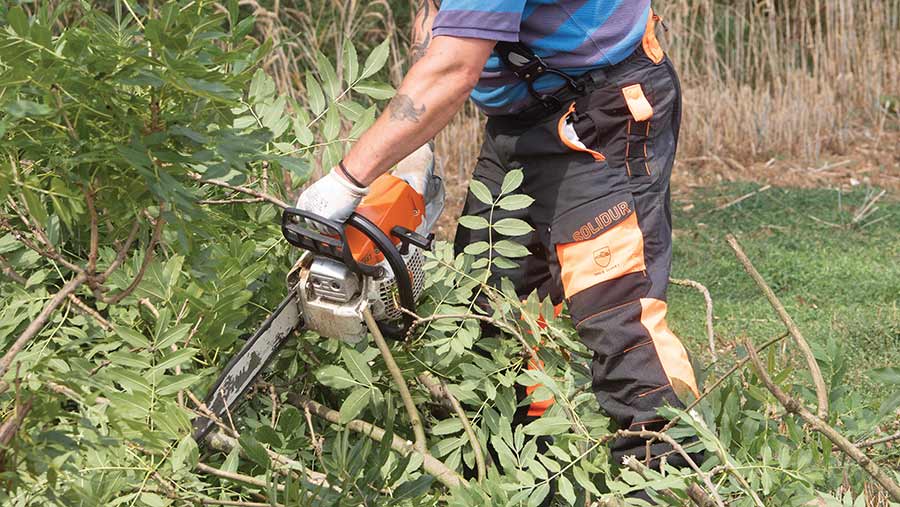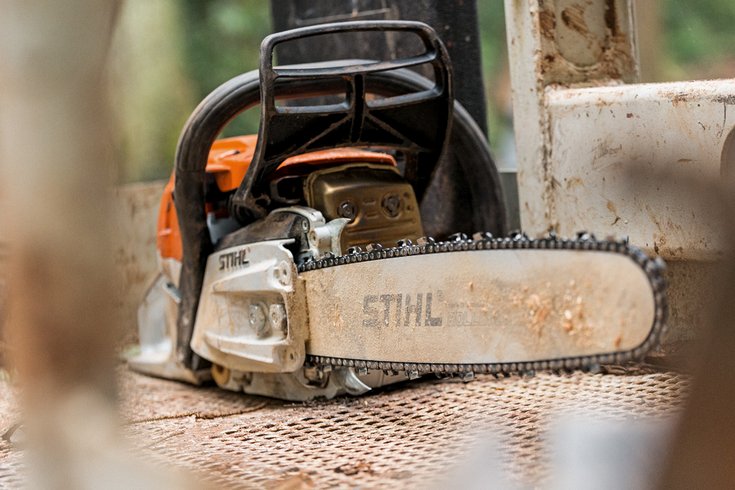Are you worried about using a farm chainsaw? Don’t be – with the right precautions and knowledge, you can use a farm chainsaw safely and confidently.
In this guide, you will discover the essential steps needed to safely use a farm chainsaw. Click now to start learning!
Farm chainsaws are a powerful tool and should be used with extreme caution. This guide will provide the basics for safe operation of a farm chainsaw, including key safety tips, best practices for pre-use checks, how to properly start it up and shut it down, how to safely fuel the machine, basic cutting techniques, and more.
It is critical for farm owners and operators to understand the potential risks associated with using a chain saw as well as how to minimize those risks by operating the equipment safely. Ignoring key safety precautions can result in serious injury or even death. By taking the time now to understand these procedures before starting work with a chain saw, you can save yourself or another person from serious harm later on.
Read this guide carefully and become familiar with its contents before attempting to use a chain saw of any kind on your farm or property.
Importance of using a farm chainsaw safely
Using a farm chainsaw can be a dangerous activity, even when used properly. It is important to understand the risks and safety precautions associated with farm chainsaw use to avoid losing limbs or even your life. This guide will provide an in-depth look at how to safely use farm chainsaws, from preparing for the job, to instructions for cutting different types of wood, along with maintenance tips for keeping your saw in top working condition.
Before starting any job with a chainsaw, it’s important to take some basic safety precautions such as wearing appropriate protective gear including chaps, helmet and hearing protection. Make sure that you have a solid footing and are operating the saw at eye level. Always check the condition of your saw before turning it on – inspect the chain tension and check the fuel and oil levels. Ensure that all guards are in place and that you know where your thumbs should be located when holding the handlebar controls.
When cutting wood with a farm chainsaw there are specific techniques that need to be followed: use proper pressure on the trigger while applying steady downward pressure; secure an off-hand grip on top of the guide bar; don’t rush – make sure you take your time and make controlled cuts; never cut above shoulder height; always let go of the pressure if binding occurs during cutting as this may lead to kickback which could cause serious injury or even death; constantly clean away sawdust which can stop up cooling fins leading to overheating; stay aware of other persons in close vicinity including spectators or helpers who may be injured by flying debris if proper safety protocols are not followed.
Finally, after each use make sure you store your chainsaw safely away from children or animals. Cleaning or servicing should only be done by qualified personnel and must adhere strictly to any manufacturer instructions provided. Keep all moving parts free from debris by regular cleaning/oiling throughout operation as this ensures maximum performance as well as accuracy whilst cutting material – if dust clogs up certain areas of the saw then it may no longer cut correctly due to reduced air flow meaning more force is required by user causing dangerous conditions in certain cases so keep those surfaces clean!

Brief overview of the guide
This guide explains the basics of how to safely use a farm chain saw, from general tips and precautions for safe chain saw operation to specific instructions for cutting wood and keeping the saw running smoothly.
It also outlines what to look for in a safe chainsaw, including features such as anti-kickback and vibration dampening technology, low emissions levels, and ergonomic design.
Additionally, the guide covers proper storage and maintenance of your chainsaw so that it is always ready when you need it.
With this comprehensive guide, you will be able to explore the exciting possibilities that a chainsaw can offer a farm while knowing that your safety is not compromised.
Preparing for Chainsaw Use
Before using a chainsaw, it is important to make sure you are prepared. Essential safety equipment is necessary when using a chainsaw and should include secure, closed-toe leather shoes or boots; gloves; protective chaps or cut resistant pants (also known as chain saw trousers); eye protection such as goggles, glasses or face masks; hearing protection such as ear plugs; and a hard hat. Additionally, you must wear long sleeves and long pants of thick material to protect from flying debris and sparks.
Make sure power cords are not frayed or damaged before plugging in the saw, and always check for gas leaks on gas-powered saws before use. It is also important to read the user’s manual that accompanies the chainsaw for instructions on factors like appropriate refueling methods and uses for the different types of blades, bars, tips and kickback guards that may be included with a particular model. Make sure the blade guard is securely attached before operating your chainsaw. If it isn’t working properly or becomes damaged during use, having it replaced will help to avoid unnecessary risks associated with kickback.
Finally check that all nuts, bolts and screws are tightened completely prior to use in order to promote safe operation.
Choosing the right chainsaw for your needs
Choosing the right chainsaw for your needs is essential for a safe and productive job. When selecting a chainsaw, it’s important to consider the size and power of your machine. Most farm-use chainsaws range from small handheld models through to larger machines used for extensive cutting or large-scale felling work. The size of the saw depends on the job you need to do as well as personal preference.
Smaller chain saws are often used for domestic jobs around the property, such as cutting firewood, trimming branches and shaping trees. They are generally at least 6 cubic centimeters (cc) in capacity, have an extension or bow bar of at least 20 inches and a noise output of less than 110 decibels (dB). Medium-sized chain saws with capacities ranging between 8cc and 40 cc are more suited to smaller scale tasks such as pruning and light tree felling. For timber-felling tasks and larger tree removal operations, select a professional-grade chain saw with at least 40 cc capacity, an extension bow bar that is 24 inches or longer and designed to operate with noise levels no higher than 107 dB.
It’s also important to consider what type of fuel your unit uses — most chainsaws use a two-stroke oil mix while some newer electric models are becoming available that don’t require fuel or oil changes. Chain oil should always be kept topped up in traditional gas powered units — not doing so can lead to severe wear on your machine potentially creating an unsafe working condition. Lastly, check the weight distribution when making your selection — heavier units can take their toll on operators during long periods of use if chosen incorrectly, so choose wisely!
Familiarizing yourself with the chainsaw parts and operation
Before you begin using a chainsaw, it’s important to familiarize yourself with the specific parts and understand how they work together. This is essential for both safety and efficiency.
Chain – The chain is a continuous loop made of several components that are designed to cut through wood. It includes several individual parts called cutters, connected by rivets or links that allow the chain to move around the circumference of the chainsaw guide bar.
Guide Bar – The guide bar helps guide the chain along its cutting path, positions it correctly against the object being cut, and helps support its weight when in operation. Chainsaws typically come with varying lengths of bars ranging from 7″ up to 32″.
Sprocket Nose – The sprocket nose is an important part of the guide bar which holds it securely in place on the skid plate and allows for smooth travel along the bar.
Bar Tip – The end of the guide bar furthest away from you while operating has a rounded tip known as a “bar nose” where you insert special blades or cutting tools.
Kickback Guide Points – Made out of metal, kickback guard points are located at each end of the tip and reduce kickback power by preventing fast-moving chainsaw teeth from hitting hard surfaces like stones in wood logs or rocks in stumps.
Engine Housing/Motor Casing – This houses two internal parts; recoil starter assembly (a cord+spring mechanism) and carburetor which regulates fuel flow towards engine cylinders when activated through a choke lever or primer button near handle grip area.

Dressing appropriately for chainsaw use
When using a farm chainsaw, it is important to dress appropriately for the task. First, you should wear clothing that covers your arms, legs and body. This means wearing a long-sleeved shirt and pants, as well as enclosed shoes such as boots or sneakers.
In addition to basic clothing requirements, you should also wear additional items to protect your body from the dangers of a farm chainsaw. Chainsaws are designed to cut through thick wood and other materials with incredible force; this can leave operators at risk of injury if proper protective items are not worn in addition to standard clothing. These items include:
- Heavy-duty leather gloves: Leather gloves not only provide you with additional grip while operating a chainsaw, they will also provide protection against the blades if they come into contact with your skin while operating the saw; they could potentially save you from serious and/or minor lacerations due to accidental contact with the blades.
- Safety glasses or goggles: Safety glasses or goggles help protect your eyes against any debris kicked up when operating your chainsaw such as chips or debris from trees or other foliage being cut down around you.
- Hearing protection: The sound produced by a running chainsaw is loud enough to damage hearing if exposed for long periods of time; ear muffs or plugs should be used when operating the tool in order to protect against hearing loss from extreme exposure.
Ensuring a safe work area
Before attempting to adjust or use a chainsaw, it is important that you assess the work area to ensure that it is safe and secure. First, look around at the environment and find/clear any tripping hazards. Objects such as small rocks, tools, pieces of wood, etc. should be removed from your chainsaw work area.
Make sure there is adequate lighting in the workspace so that you can see what you are doing clearly. Once these two issues have been addressed, make sure all loose objects are secured before moving on to the next step. For example, long hair should be tied back and clothing should be tucked-in so that it does not get caught in the chain of your chainsaw during operation.
Next, ensure that there is a clear line of egress from the workspace if something were to happen or go wrong (i.e., make sure there is an accessible way out of the area if some type of emergency were to occur). Finally, assess for any possible kickback zones; these would include areas where limbs or tree trunks might break off and cause a kickback reaction when chainsawing them near trees or other items in your workspace. Once these precautions have been taken, you can proceed with using your chainsaw safely and securely!
Chainsaw Maintenance
It’s important to keep your chainsaw in good running condition and ensure that it remains safe to use. Regular maintenance should be part of your routine when using a chainsaw, no matter how often you use it. The following steps should be followed each and every time you take your chainsaw out for use:
1.Check the chain tension: A loose chain can result in poor performance or cause the chain to come off when running. Adjust the chain tension according to the manufacturer’s instructions.
2.Check the air filter: Cleaning or replacing an air filter helps improve engine performance and prolongs engine life. Make sure to inspect and/or clean your air filter as per manufacturer’s instructions.
3.Ground rules: Always wear appropriate safety gear, such as hearing protection and gloves, before starting any work with the chainsaw. Make sure you have a firm grip on the saw before starting it up, avoid putting yourself in any awkward or unsteady positions and keep all bystanders at a safe distance from where you are working with the saw
4.Look for fuel leaks: Look for any signs of leakage in both fuel tanks before using it each time; also make sure that there are no obstacles near where you will be operating a chainsaw so as not to create sparks from contact with rocks or other hard objects that could ignite leaked fuel fumes if present
5 Check oil levels: It is essential to check oil levels each time before using a chainsaw; ensure that oil reaches at least half-way up the dipstick but not more than three-quarter full to ensure efficient operation without overloading engine components
6 Cleaning and sharpening blades: Clean debris off cutting blades after each use; dust particles can form barnacles on blades which reduce efficiency over time, so make sure that they are cleaned regularly as well as sharpened prior or after each use according to manufacturer instructions.
Keeping the chainsaw in good condition
In order to keep your chainsaw running as safely and efficiently as possible, regular maintenance checks should be made. Before use, check all parts of your saw, including the chain brake and chain catching device.
When using a chainsaw, ensure that the design safety features remain in good working order at all times. Additionally, be sure to inspect the saw blade for any sharpness or nicks, as these can cause kickbacks or other accidents during operation. Be aware of any signs of damage or wear that may affect the operation or safety of use.
Regularly clean all dirt and debris from internal components to ensure proper functioning of the machine. Replace parts such as blades and spark plugs as needed throughout its lifetime to maintain optimal performance.
Sharpening the chainsaw chain
A sharp chain will help reduce the risk of kickbacks, vibration, and poor cutting performance. You should always regularly sharpen your chainsaw chain before and during use with a round file that is the same diameter as the drive link, followed by filing with a flat file.
First, secure the saw’s guide bar in a vice. This is to ensure that when sharpening each cutter, you don’t inadvertently alter its profile or depth setting. When positioning the file in relation to the saw tooth use two reference points; 90 degrees to the scriber line on each side of the cutter. After every few strokes, rotate the flat rear face of your file away from cutting cutters before traveling up and down that portion of raker gullet line.
Finally check for correct sharpening angles by placing a square block against any three successive cutters in turn and checking for contact along their entire length – this will ensure that all teeth are ground at equal angles by visualising their lengthwise profile from inside edge to outside edge (where drive links are attached). Change up direction or styles if different or new techniques are needed mid-process; simply switch off saw’s power source first for safety reasons then continue as normal but make sure to start from beginning on subsequent procedures until complete satisfaction is achieved: Over-filing may lead subpar performance so caution should be applied here!
Cleaning the chainsaw
Maintaining a working chainsaw is key to safely and effectively cutting down trees. It is important to note that all safety precautions should be followed when doing tasks involving a chainsaw, including cleaning. To keep your chainsaw in proper working condition, regular cleaning and maintenance will be necessary.
As part of the routine maintenance of your chainsaw, you will want to dust off the outside of the chainsaw using either a dry brush attachment or a small vacuum cleaner with an appropriate nozzle. This can be done on either a wet or dry saw but keep in mind that using a dry saw will reduce the risk of encounters with water at extreme temperatures.
You should also clean any exposed parts on your chainsaw including its fuel system and air filter regularly. Generally, these parts can be wiped off with an old rag; applying some light motor oil can help to make sure that any exposed metal parts don’t rust. The chain itself may require more attention and will likely need periodic sharpening as well as lubrication with oil at the beginning of each day’s use (or after every 5-10 tanks of fuel). Make sure you check for any visible signs of wear or damage before proceeding and always follow all safety guidelines when performing these tasks.

Conclusion
For those who use a farm chainsaw regularly, it’s important to stay informed about the proper safety protocols and precautions. Due to the fact that these tools contain particular risks associated with their use, it is important to acquire the necessary skills to use them safely and properly.
Farmers who intend to use a farm chainsaw should take into consideration the basic preventive measures they can take before they specialize tasks or begin to utilize it. Regular maintenance of the tool is essential in order to guarantee that it functions correctly and properly every time you use it. Your chain must always be lubricated and needs frequent examination as well as sharpening or replacement when necessary. Furthermore, you should always ensure that your protective clothing fits you comfortably before getting right into work with your farm chainsaw.
To sum up, everyone who intends on using a farm chainsaw must become familiar with the appropriate safety procedures for using one safely before taking any action with the chainsaw itself. Doing so will help make sure that both yourself and those around you are protected from potential harm when working on things around your property or agricultural business.
FAQ
What is the safest way to use a chainsaw?
The safest way to use a chainsaw is to wear appropriate protective gear, ensure the chainsaw is properly maintained, follow the manufacturer’s instructions, and use proper cutting techniques.
What is the proper procedure for cutting with a chainsaw?
The proper procedure for cutting with a chainsaw includes checking the chainsaw and surrounding area for safety, positioning oneself properly, starting the chainsaw, making the cut, and then shutting off the chainsaw.
What are the most common chainsaw accidents?
The most common chainsaw accidents include kickback, chainsaw cuts, and falling objects.
What causes kickback on a chainsaw?
Kickback on a chainsaw can be caused by improper cutting techniques, hitting a foreign object while cutting, or a poorly maintained or damaged chainsaw.
How do you not pinch a chainsaw?
To avoid pinching the chainsaw, the operator should use a proper cutting technique, ensure the chainsaw is properly maintained, and be aware of the position of the saw chain.
Is there a safety on a chainsaw?
Yes, most chainsaws have a safety switch or button that must be engaged before the chainsaw can be started.
How bad are chainsaw injuries?
Chainsaw injuries can be severe and even fatal, including lacerations, amputations, and serious trauma.
How do you avoid a kickback from a chainsaw?
To avoid kickback, the operator should use proper cutting techniques, maintain a firm grip on the chainsaw, and avoid cutting with the tip of the chainsaw.
What is a common problem with a chainsaw?
A common problem with chainsaws is a dull or damaged saw chain, which can affect cutting performance and increase the risk of accidents.
Is it safe to chainsaw in the rain?
It is generally not safe to chainsaw in the rain, as wet conditions can increase the risk of slipping or losing control of the chainsaw.
See Also :
- Best chicken coops for 6 chickens 2023
- Best chicken plucker 2023
- Best chicken waterer 2023
- Best clippers for goats 2023
- Best commercial wood chipper 2023


